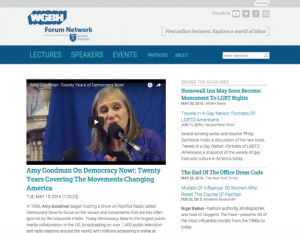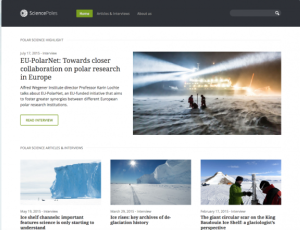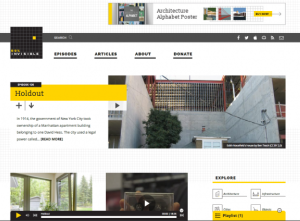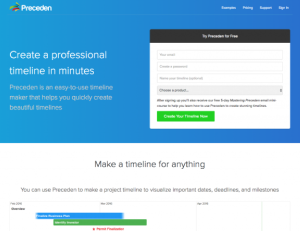Research and Education
Back to Top
|
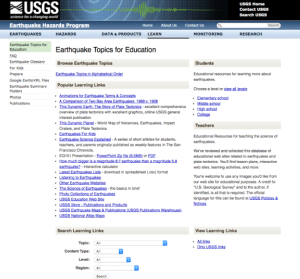 |
|
USGS: Earthquake Topics for Education
|
Science |
|
The United States Geological Survey (USGS) has gathered together this collection of Earthquake Topics for Education, which consists of over a dozen learning links to USGS resources. Popular items include an Animations for Earthquake Terms & Concepts, A Comparison of Two Bay Area Earthquakes: 1989 v. 1906, and This Dynamic Earth: The Story of Plate Tectonics, among others. While elementary school, middle school, and high school teachers will find excellent enhancers of all kinds for earthquake related lesson plans and activities, general readers will also find much to appreciate. For instance, anyone fascinated by the drama and history of geophysics will find much to admire in the Other Earthquakes Websites link that suggests such sites as the American Geophysical Union, the California Geological Survey, and the Center for Earthquake Research & Information. Readers may also note that the entire collection of resources is easily searchable when using the Search Learning Links function, found at the bottom of the page. [CNH] |
|





|
|
 |
|
Reading, Writing, and Researching for History: A Guide for College Students
|
Language Arts |
|
This writing guide from Bowdoin College professor Patrick Rael focuses its intellectual vigor on "Reading, Writing, and Researching for History." Designed for undergraduate students, the material covered here may also be helpful for advanced high school students, graduate students, and lifelong learners. The depth and breadth of the guide is noteworthy; Professor Rael guides his readers through sections on Reading, Historical Arguments, Research, Structuring Your Paper, Writing Your Paper, Working with Sources, Editing and Evaluation, and the Writing Model. Each section is broken down further into subheadings that can be downloaded as freestanding PDFs. For instance, readers will find a handy Paper-Writing Checklist within the Editing and Evaluation section or suggestions for How to Read a Primary Source in the Reading section. Whether browsing the guide in its entirety or selecting specific sections of interest, the material here may provide a handy tool for students and teachers alike. [CNH] |
|





|
|
 |
|
Utah Education Network: Physical Education
|
Physical Education |
|
For the physical education teachers who are on the look out for fresh perspectives and new activities that will engage their students and liven up their days, the Utah Education Network has provided dozens of resources that can do just that. On the site, lessons plans are organized by grade, starting with third grade and moving one grade at a time up to the eighth grade (for Kindergarten, first, and second grades, readers may click on a link to navigate to a separate page). Along the way educators will find fun and educational exercises. For example, PE with a Hint of History uses large pictures of famous people, inventions, and countries to combine learned history/social studies facts with PE activities and skills. Shark Island, meanwhile, uses scooters, balls, bean bags, or whatever materials are on hand to institute an advanced game of tag with an emphasis on team building. [CNH] |
|





|
|
 |
|
Hip Hop, Popular Music and Education
|
Arts |
|
For educators who would like to integrate Hip Hop music into their lesson plans, the WISE (Working to Improve Schools and Education) program at Ithaca College has assembled this list of Hip Hop resources. General readers and educators alike might like to begin by selecting The History of Hip Hop, where they can read how Hip Hop got started, how it developed, what it means, and where it's going. Readers may also like to scout other links, such as Hip Hop History 101, Hip Hop: Today's Civil Rights Movement?, and The Hip Hop Classroom. Other fascinating links include bell hooks Discusses Rap, the Poetics of Hip Hop, and the Evolution of Rap Music in the United States. Both educators and general readers who would like to understand Hip Hop and harness its cultural power for educational purposes will find much to appreciate in this comprehensive list of resources. [CNH] |
|





|
|
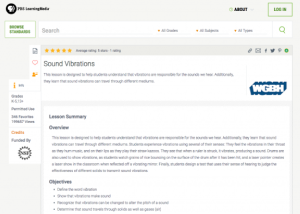 |
|
PBS LearningMedia: Sound Vibrations
|
Science |
|
PBS LearningMedia has designed this detailed lesson plan to help students understand the role of vibrations in interpreting and experiencing sound. Assembled with elementary school students in mind, the lesson, which has been viewed nearly two hundred thousand times, begins with a clear Overview. From there, it outlines the Objectives of the lesson, suggests the appropriate time needed to complete the lesson (approximately three class periods), and then offers readers links to nine different Multimedia Resources. While the lesson requires specific materials, such as plastic drinking straws, scissors, and large balloons, most of them are easily acquirable and inexpensive. [CNH] |
|





|
|
 |
|
NSF: Earth & Environment Classroom Resources
|
Science |
|
The Classroom Resources section of the National Science Foundation website is extensive and impressive. Take, for instance, this collection of Earth & Environment Classroom Resources. Here educators will discover links to 16 different resources, most of which have been culled from the National Science Digital Library (NSDL). Notable resources include the Earth & Environment Research Overview, a site that explains the important work that scientists are doing on the feedback loop between how humans impact the environment and how the environment, in turn, affects human communities. The material here ranges from K-12 to higher education. For instance, while college instructors may be interested in the Science Education Resource Center at Carleton College, an organization that works to improve undergraduate science education through projects that focus on faculty support, elementary school teachers may prefer Geography4Kids, which helps younger children explore the earth through engaging activities. Indeed, this list of more than a dozen resources has a little something for everyone. [CNH] |
|





|
|
 |
|
NBC Learn: Free Resources
|
Educational Technology |
|
NBC News has been reporting on national and international events for more than 80 years, and NBC Learn, the educational arm of NBC News, has assembled a stellar collection of stories, images, and source documents for educators, parents, and students. Typically, videos on display are less than six minutes long, yet they are produced as complete stories and feature famed journalists, including Tom Brokaw, John Chancellor, and Tim Russert. For quick browsing, the video resources may be narrowed into four broad categories: Language Arts, Humanities & Social Sciences, STEM & Innovation, and Others. Within the STEM & Innovation category, for example, features include such entertaining and educational subtopics as Science of the Olympic Games and Science Behind the News, each of which features a number of streamable videos. [CNH] |
|





|
|
 |
|
Digital Harlem
|
Social studies |
|
Once home to prolific artists and writers such as Louis Armstrong, Langston Hughes, and Zora Neale Hurston, early 20th century Harlem was a rich African American cultural hub. But this site, developed by historians and arts researchers at the University of Sydney, does more than document the characters and events of note during this period, offering instead a glimpse into the lives of ordinary Black New Yorkers living in the Harlem Neighborhood between 1915 and 1930. Using records drawn from newspapers, legal sources, and other archives, this resource uses a map interface to provide a way to explore and visualize Harlem's rich history. Readers can use the search features on the left of the website to create their own maps of people, places, or events, or use the sidebar on the right to explore already created maps on different themes, such as gambling arrests or the life of seventeen-year-old Fuller Long. Tabs at the top of the site provide even more information on how the site can be used and understood to research the rich history of Harlem and its everyday people. [MM] |
|





|
|









